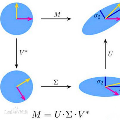This paper presents a study of continuous encryption functions (CEFs) of secret feature vectors for security over networks such as physical layer encryption for wireless communications and biometric template security for online Internet applications. CEFs are defined to include all prior continuous "one-way" functions. It is shown that dynamic random projection and index-of-max (IoM) hashing algorithm 1 are not hard to attack, IoM algorithm 2 is not as hard to attack as it was thought to be, and higher-order polynomials are easy to attack via substitution. Also presented is a new family of CEFs based on selected components of singular value decomposition (SVD) of a randomly modulated matrix of feature vector. Detailed empirical evidence suggests that SVD-CEF is hard to attack. Statistical analysis of SVD-CEF reveals its useful properties including its sensitivity to noise. The bit-error-rate performance of a quantized SVD-CEF is shown to exceed that of IoM algorithm 2.
翻译:本文介绍了对网络安全秘密特征矢量的连续加密功能(CEFs)的研究,例如无线通信的物理层加密和在线互联网应用的生物识别模板安全。CEFs的定义包括所有先前连续的“单向”功能。它表明动态随机投影和最大量指数(IoM)散射算法1不难攻击,IOM算法2不象人们想象的那样难以攻击,更高层次的多级矢量算法2很容易通过替代攻击。还介绍了基于随机调整的特性矢量矩阵单值分解(SVD)某些部分的CEFs新组合。详细的实证证据表明SVD-CEF很难攻击。SVD-CEF的统计分析显示了其有用特性,包括它对噪音的敏感度。四分级SVD-CEF的比特-eror-速率表现显示超过IOM算法2的特性。
相关内容
Source: Apple - iOS 8




